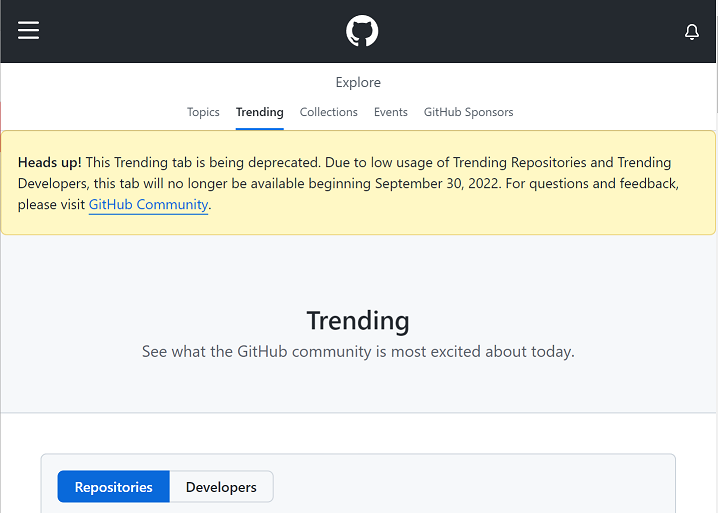
Microsoft-owned GitHub landed an unwelcome surprise on its developer community before the weekend by greeting users of its list of trending repositories and developers with a banner stating that the Treding tab was being killed off.
“Heads up! This Trending tab is being deprecated” GitHub said on Friday. “Due to low usage of Trending Repositories and Trending Developers, this tab will no longer be available beginning September 30, 2022. For questions and feedback, please visit GitHub Community.”

Questions and feedback duly arrived, with comments like “This tab is my default page to access GitHub. I go there every day to discover new projects. I’m flabbergasted by that decision…” and “That’s insane. Everybody who is truly interested in open source uses this page very often.”
A day or so later, GitHub VP of Developer Relations posted a conciliatory and partial retraction saying that: “Given the feedback here, it’s clear we need to look again at the plan to deprecate this. The team is going to re-evaluate and see if we can come up with some other options.” He added that “usage has stagnated” and that “the data pipeline that powers the page has historically proven problematic to maintain.” The banner has gone for now.
It was notable though that GitHub appears not to have consulted with its users over the removal of this long-standing feature, and that the notice period of one month was short.
It is possible for third-parties to use GitHub’s API to create their own lists of trending repositories like this one but not easy thanks to bots clouding the figures – which may be a factor in Woodward’s reference to a problematic data pipeline. GitHub’s list does a good job of identifying new and significant open source projects.
One possibility is that GitHub would prefer developers to use its personalized “Explore” tab which uses AI to identify projects “based on your interests”. Explore also includes ads whereas Trending does not. Developers have reported though that Explore is less effective in identifying what they are actually interested in than the non-personalized Trending tab.
GitHub is critical to the open source community. WebKit, the engine behind Apple’s Safari web browser, was recently moved to GitHub, with Apple software engineer Jonathan Bedard saying that “GitHub’s API let us build out advanced pre-commit and post-commit automation with relatively minor modification to our existing infrastructure, and provides a modern and secure platform to review and provide feedback on new code changes.”
GitHub itself though is not open source, nor is it run by its community. Microsoft CEO Satya Nadella said of the acquisition that “we’ll bring Microsoft developer tools and services to new audiences” and that way make sense of what must be an expensive platform to run, bearing in mind its generous free tier especially for open source projects. Nadella also said at the time (2018) that “we’re committed to being stewards of the GitHub community, which will retain its developer-first ethos, operate independently, and remain an open platform.”
Although GitHub’s continuing service to the open source community is not in question, the status of “operate independently” is more doubtful. As one would expect, Microsoft has tied GitHub to Azure in some key areas, most notably its Codespaces remote development feature which uses Azure VMs.
Geoffrey Huntle, formerly a developer advocate at competitor GitPod, has claimed that “GitHub Codespaces is a devdiv project that now belongs to GitHub,” where devdiv means Microsoft’s Developer Division, and that the Visual Studio Code (VS Code) IDE combined with GitHub “is their ecosystem that they control and they are in absolute control.”
That said, GitHub and VS Code together provide a DevOps platform that is free for many of its users and both are massively popular. It is a blend of corporate self-interest and community support that has worked so far, thanks to Microsoft’s deep pockets and the fact that it has a cloud platform to sell. The Trending tab on its own is not such a big deal, but the company will be mindful of the inherent risks if it alienates its already-wary open source community.
